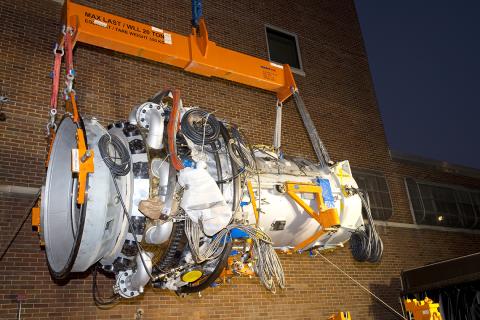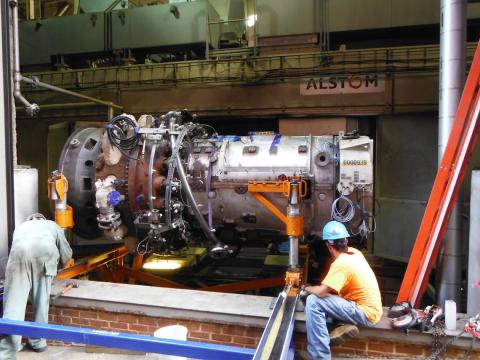Will Save Millions
ORF Upgrades Cogeneration Power Plant

A combustion turbine that has efficiently powered a generator in NIH’s Cogeneration Plant for the past 12 years has recently been replaced with a newer, more efficient model.
The new unit, similar in technology to aircraft jet engines, is a Siemens SGT-600 3rd generation dry low emissions combustion system gas turbine. It replaces the 12-year-old ABB GT10 gas turbine, said Dr. Farhad Memarzadeh, director, Division of Technical Resources, Office of Research Facilities. The new engine begins supplying energy to campus this month.
Cogeneration or “cogen,” he explained, is a process where a fuel source, like natural gas, is used to produce steam and electricity simultaneously, requiring much less fuel (and fewer emissions to the atmosphere) than producing each form of energy separately. Because of its efficiency, the cogen plant produces electricity that’s 60 percent less expensive than it would cost to purchase from the local electrical grid. Prior to the introduction of the cogeneration system, NIH bought all its electricity from Pepco, which currently burns mostly coal and some oil and gas in large power plants to produce electricity.
“Like its predecessor, this new engine will save us millions of dollars each year—savings that enable us to conduct more science than otherwise possible,” said ORF Director Dan Wheeland.
The turbine engine fueled by natural gas is the heart of the cogeneration plant, which produces 23 million watts of electricity—enough to power 14,000 average homes in Maryland, Memarzadeh said. The plant meets approximately 35 percent of NIH’s electricity requirement and provides 40 percent of NIH’s steam production.
Purchasing natural gas for the cogeneration plant uses a unique strategy, developed and managed by DTR. The purchasing strategy helps NIH minimize exposure to seasonal short-term price spikes and maintains flexibility in order to take advantage of possible future natural gas price declines. Extensive analyses are performed daily to determine purchasing strategy. DTR employs highly advanced mathematical modeling based on an artificial neuron network in conjunction with Holt-Winter triple exponential smoothing that takes into account seasonal and trend changes. Based on the results of these models, DTR establishes a specific procurement plan for that period based on market conditions and project economics. This strategy has saved NIH more than $11 million in the last 12 years compared to the standard natural gas purchasing strategy.

Located near the center of campus, the 7,800-square-foot plant has been in operation since 2004. The original engine was a prototype built in Sweden and modified by Siemens and NIH. It sits next to the Central Utility Plant (CUP), which houses five traditional gas and oil-fired boilers. The original unit was one of the cleanest cogeneration plants in the world, with emissions 44 percent lower than similar plants operating without add-on emission controls. Since cogeneration was fired up in 2004, it has saved NIH more than $50 million.
The CUP provides all of the campus’s requirements for heating, cooling and humidity, while ensuring efficiency and reliability. It’s one of the largest utility plants under one roof in the world. The amount of natural gas burned annually in the CUP is equivalent to 25 million gallons of gasoline. The total energy use (fuel and electricity) at NIH is equivalent to the energy used by 50,000 average Maryland homes. More than 10.5 million data points a day are collected and analyzed using 150,000 advanced calculations from about 1,600 continuously running analyses. Memarzadeh can see every data point and calculation on monitors in his office.
In the early 1990s, Memarzadeh and his colleagues were faced with a tough question: how does NIH meet increasing energy needs while reducing carbon emissions? They settled on cogen technology because it allowed them to meet the needs of a growing campus while reducing emissions.
“Farhad uses the pronoun ‘we,’ but the truth is his single leadership and understanding of complex systems are the reasons this project is successful,” said Wheeland. “He has done an exceptional job in overseeing a transformation of the plant.”
The cogen plant reduces carbon dioxide (a greenhouse gas) emissions equivalent to removing 10,000 cars or 3,000 homes. In 2011, the Environmental Protection Agency awarded NIH the Energy Star Combined Heat and Power Award. “It’s one of the cleanest cogen plants in the world,” Memarzadeh said.
After 12 years and 100,000 hours of use, it was time to replace the old engine. He said the new engine “is the first of its kind to be installed in the United States.” The newly upgraded turbine engine is a twin-shaft core engine, consisting of a gas generator plus a free-spinning power turbine.
The new engine improves on the overall unit design, combustion, hot gas path components and monitoring/protection. The upgrades will make the engine cheaper to run and maintain over its life. The new design will save NIH an estimated $7 million a year in steam and electricity costs.
In addition to saving money and reducing carbon emissions, the cogen plant allows NIH to “continue critical operations should there be a regional power outage,” added Wheeland.
Wheeland compared ORF staff to a touring rock band’s road crew. If scientists are the rock stars, ORF staff “work behind the curtains” to make sure scientists have everything they need to conduct well-designed experiments.
“Without chilled water and steam—especially in the peak months of winter and summer—we wouldn’t have patients, research animals and data centers,” Wheeland said.
